

Nevada is home to many different forms of wildlife, including several types of snakes.
©iStock.com/gguy44
Known for its beautiful mountains, lakes, and deserts, Nevada is home to many different forms of wildlife, including several types of snakes. While snakes often inspire fear in hikers and campers, they are not typically dangerous, and they are important to maintaining balance in Nevada’s ecosystems. Even the more dangerous snakes like rattlesnakes are not typically aggressive. But what about black snakes in Nevada? Let’s look at eight different types of black snakes that you might encounter in Nevada so you can better identify them and feel prepared for your next outdoor adventure!
1. Speckled Rattlesnake (Crotalus mitchellii)

Speckled rattlesnakes are venomous pit vipers with a distinctive appearance
©iStock.com/reptiles4all
One of the few dangerous black snakes in Nevada is the speckled rattlesnake. However, these venomous pit vipers only live in the southernmost tip of Nevada. Their colors and patterns help them to blend into their surrounding environments, often in habitats with buttes, mesas, desert outcroppings, thorn scrub, woodlands, sagebrush, and deserts. Speckled rattlesnakes come in a wide variety of different colors to match these environments and have colored speckles and dark bands along the length of their bodies. Snakes in darker, rocky areas are often darker in color to provide them with effective camouflage.
Speckled rattlesnakes are heavy-bodied pit vipers with broad, triangular-shaped heads. They grow between 23-52 inches long, with a segmented rattle on the tips of their tails. Because these snakes are masters of camouflage, it is very important to listen closely and to watch where you step when you are outdoors in Nevada. Many snakes will rattle their tails in warning, but some will stay quiet and try to blend into their surroundings. They are not aggressive snakes, but you don’t want to bother them since they are venomous. Rattlesnake bites require hospital treatment.
2. Western Shovelnose Snake (Chionactis occipitalis)
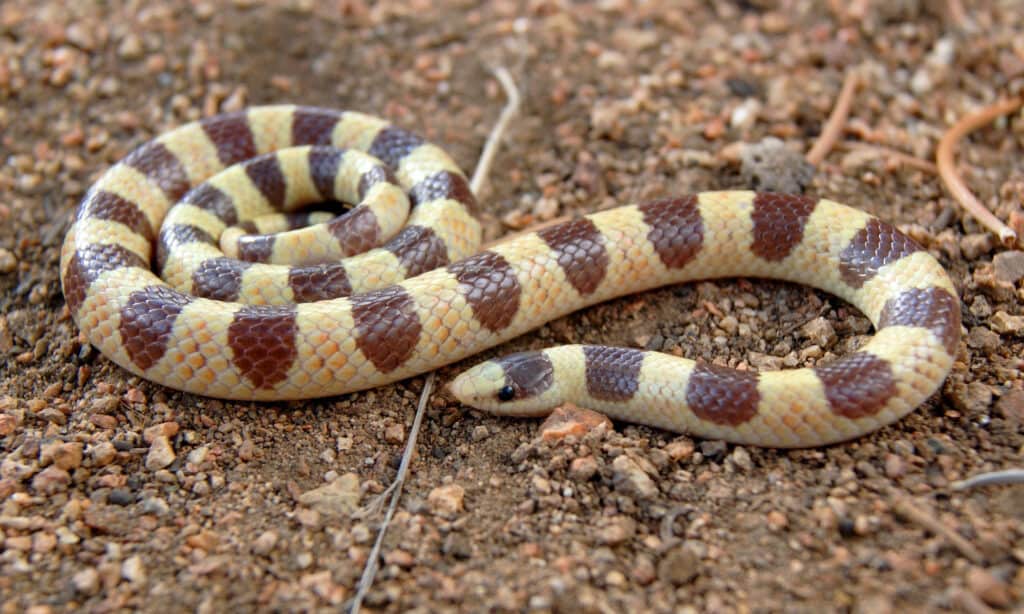
Shovelnose snakes have a uniquely flattened snout which they use for digging in the soil with
©Matt Jeppson/Shutterstock.com
These small black snakes live in southern Nevada, usually in rocky canyons and valleys, as well as sandy deserts. They most prefer sandy areas, however, like sand dunes, where they can bury themselves beneath the sand. Shovelnose snakes have uniquely flattened snouts that are shaped like shovels, and they use these to dig quickly through loose sand. They grow between 10-17 inches long with pale yellow or tan bodies. Dark brown or black saddles or stripes run along their backs, and some snakes may also have red-orange coloring in between. Western shovelnose snakes are harmless to humans, and eat small invertebrates like spiders, scorpions, centipedes, crickets, and larvae of beetles and moths.
3. Ring-Necked Snake (Diadophis punctatus)
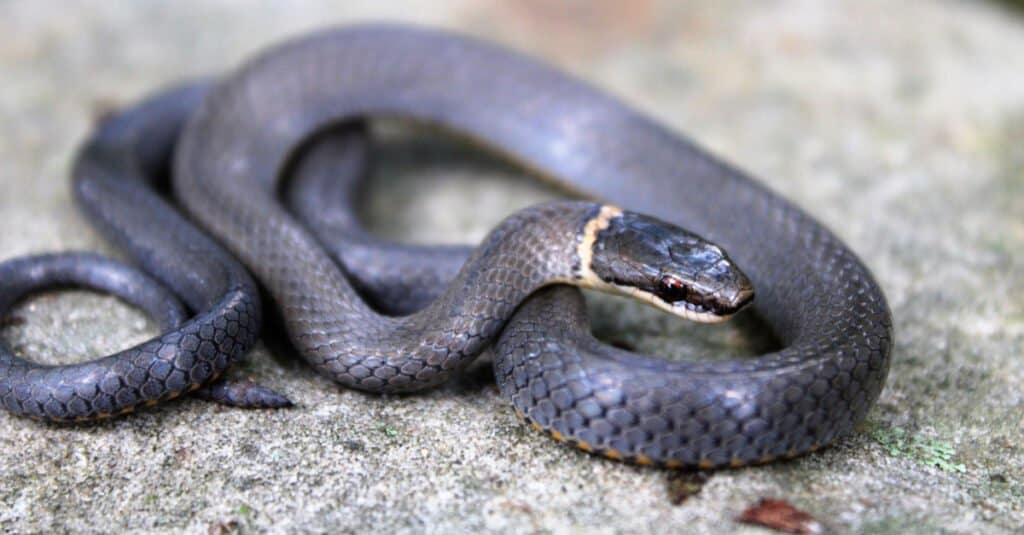
Ring-necked snakes are distinguished by the ring of color around their neck
©Tucker Heptinstall/Shutterstock.com
Another rather small black snake in Nevada is the ring-necked snake. These slender-bodied snakes live in southern Nevada in a wide variety of different habitats. They are secretive snakes that take cover and hide much of the time, which makes it unlikely that you will encounter one. Ring-necked snakes in Nevada grow between 10-15 inches long and have black, blue-black, olive, or greenish-gray bodies. Their bellies are bright red, orange, or yellow, and they have a ring around their necks in the same color. Ring-necked snakes have mild venom, but they are not harmful to humans. They eat amphibians, mollusks, and worms.
4. Eastern Kingsnake (Lampropeltis getula)
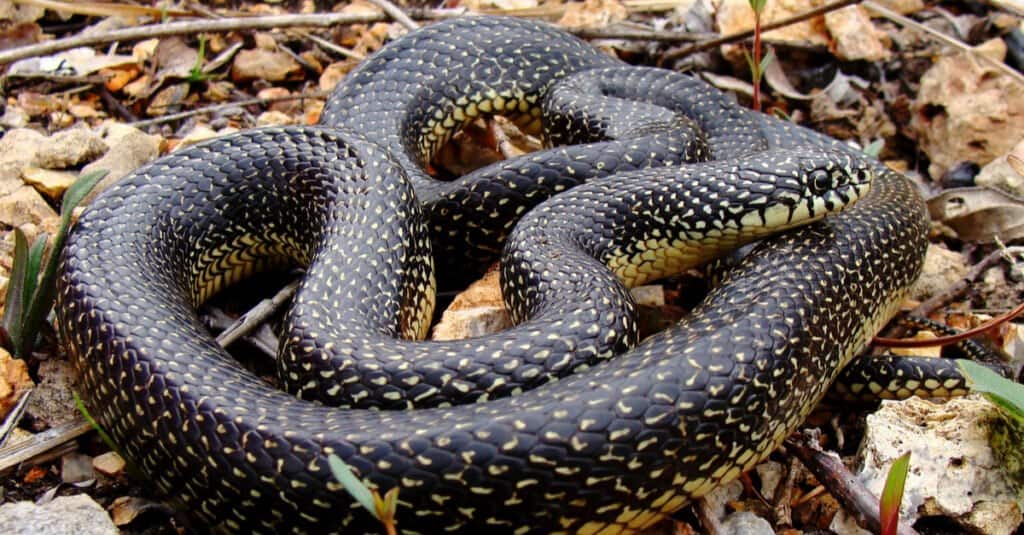
Kingsnakes are known for their ability to eat other snakes – even venomous ones!
©Matt Jeppson/Shutterstock.com
Located in western Nevada, the Eastern kingsnake is a beautiful black snake that comes in a wide variety of different patterns. These snakes can be dark brown or black, with vibrant white or pale-yellow bands, rings, stripes, bars, or spots. Kingsnakes living in the mountains are often black, with only thin white patterns. Eastern kingsnakes live in forest areas, grasslands, deserts, rocky fields, and occasionally near riverbanks and swamps. They typically eat lizards, rodents, birds, amphibians, turtle eggs, and other snakes.
5. Desert Striped Whipsnake (Coluber Masticophis taeniatus taeniatus)
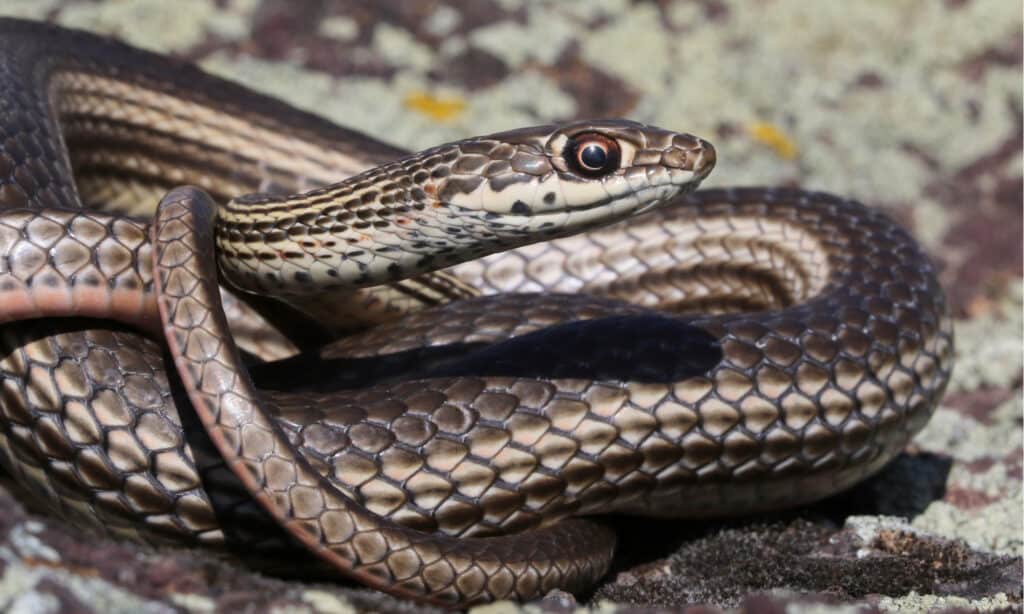
Desert striped whipsnakes are quick-moving snakes that can be aggressive if threatened
©Randy Bjorklund/Shutterstock.com
The desert striped whipsnake can be found all across the state of Nevada. These snakes live in canyons, grasslands, sagebrush flats, pine-oak forests, shrublands, and juniper woodlands. However, they prefer areas with rocky streams, flatlands, and mountains. They are quick-moving snakes and are not dangerous to humans. They usually try to slither away quickly if encountered. However, if a desert striped whipsnake feels cornered, it can lash out and strike aggressively. These snakes eat small mammals, amphibians, insects, other snakes, birds, and eggs.
Desert striped whipsnakes grow between 24-67 inches long and have slender, whip-like bodies. They are usually black, grey with an olive or blue tint, or dark brown, and have two pale-yellow stripes running along their backs. Their bellies are cream or pale yellow as well, although towards their tails the belly color transitions into a reddish hue.
6. Long-Nosed Snake (Rhinocheilus lecontei)
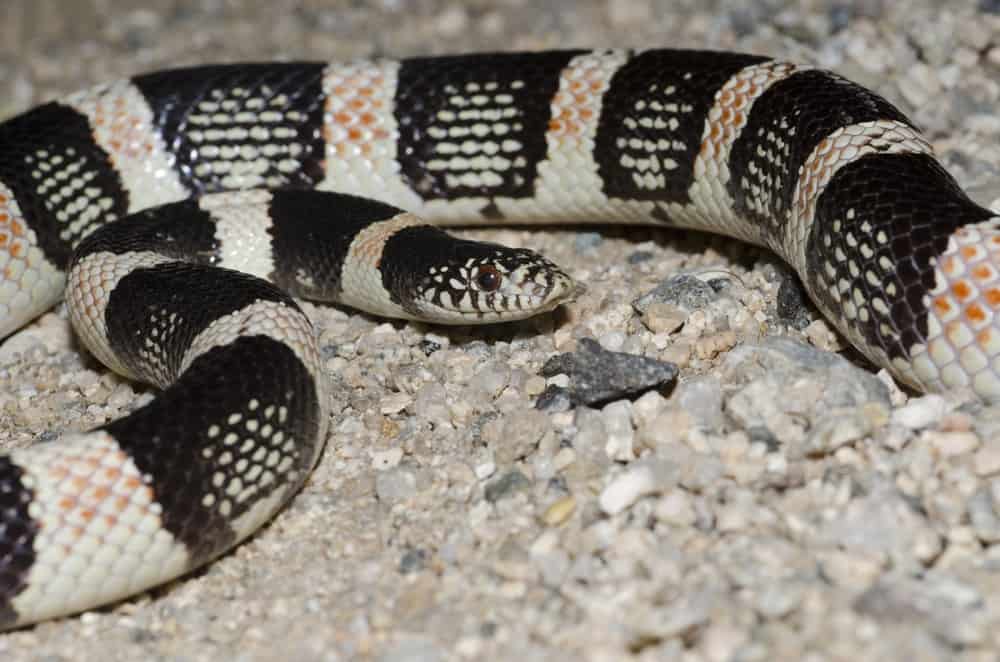
A harmless Long-nosed Snake (Rhinocheilus lecontei) found in the desert.
©Jason Mintzer/Shutterstock.com
Like their name, long-nosed snakes have unusually long snouts that are slightly upturned. These snakes live in the southern half of Nevada and along the northwestern edge of the state. They prefer arid and semi-arid desert habitats, as well as prairies, shrublands, and grasslands. Long-nosed snakes are nocturnal, but you might see them slithering across roads at night. They mostly eat lizards and amphibians, although on occasion they may also hunt rodents and other snakes.
Long-nosed snakes look very similar to coral snakes or milk snakes, with black and red-orange stripes on cream or pale-yellow bodies. However, these snakes are not dangerous, and their patterns fade along the sides of their bodies into more of a speckled or checkerboard-like design. Long-nosed snakes are usually between 30-40 inches long.
7. Valley Garter Snake (Thamnophis sirtalis fitchi)
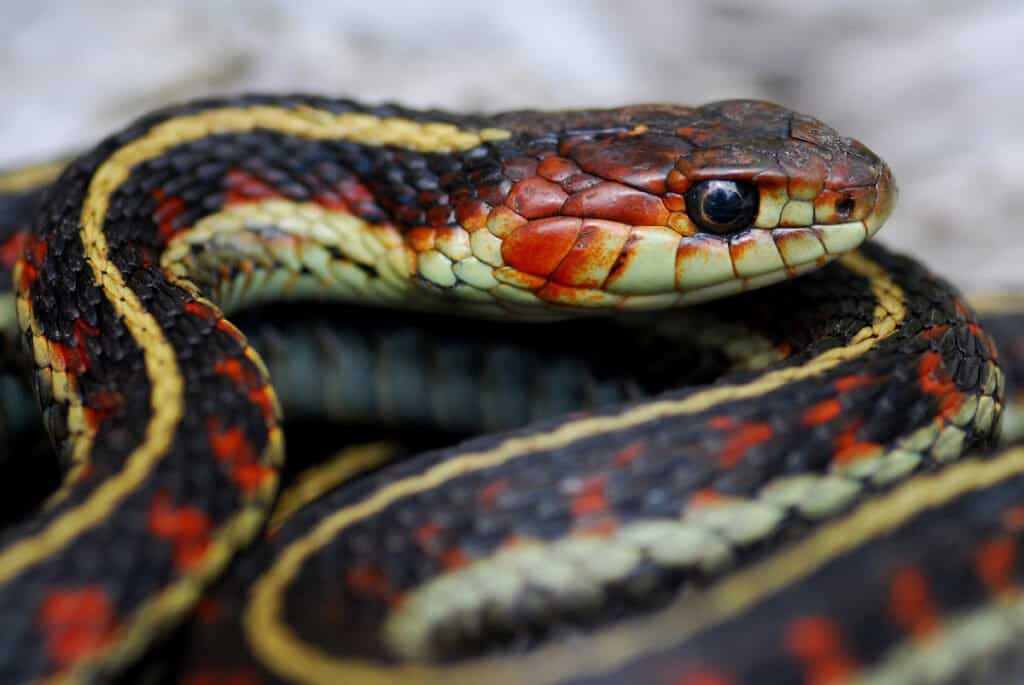
Valley garter snakes contain mild venom but are not dangerous to humans
©Jason Mintzer/Shutterstock.com
Although garter snakes have a very mild venom that they use to subdue their prey, they are not dangerous or harmful to humans. If you try to handle one, it might bite you, which could cause some swelling, however. Valley garter snakes live along the westernmost edge of Nevada in a wide variety of different habitats. They can be found anywhere from streams, marshes, and ponds to agricultural areas and farmlands, as well as mixed woodlands, chaparral, forests, and grasslands.
Valley garter snakes are usually between 18-55 inches long with slender brown or black bodies. They have three yellow stripes – one along the middle of their backs, and one along each side of their bodies. There are also additional red bars or checkered-like patterns between the yellow stripes along their sides. Their chins, jaws, and bellies are a yellowish color, while their heads are black and sometimes have red markings on the sides.
8. Sierra Garter Snake (Thamnophis couchii)
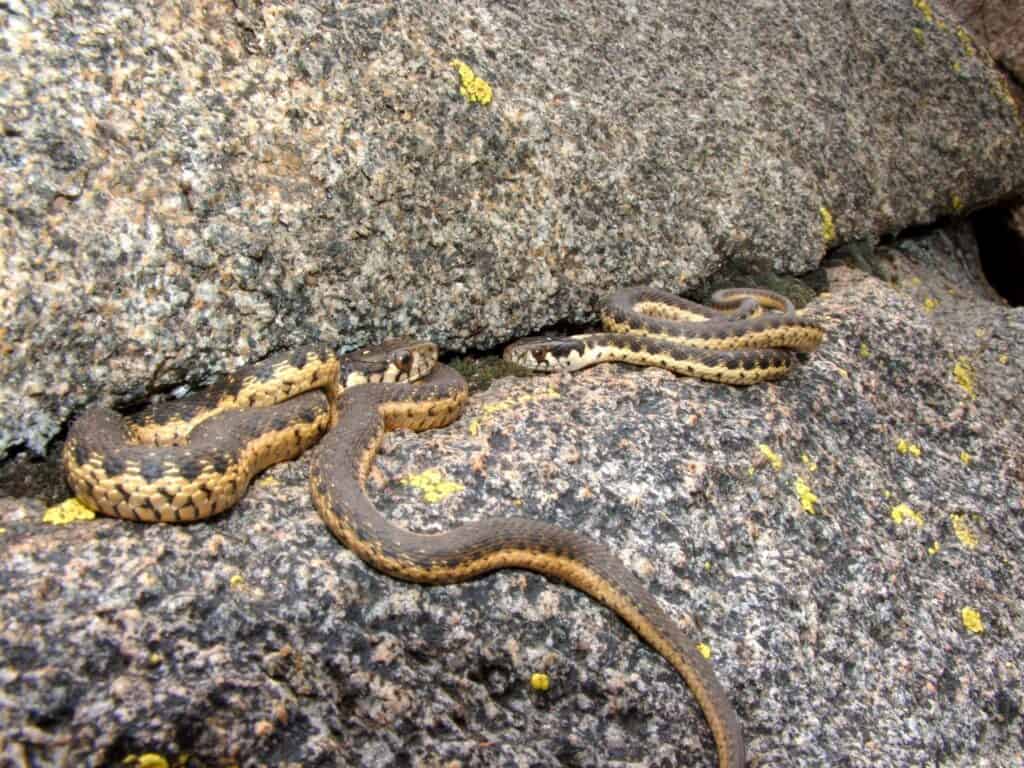
Sierra garter snakes spend a lot of their lives in water
©Matt Jeppson/Shutterstock.com
Another black garter snake in Nevada is the Sierra garter snake, which is found along the western-central edge of the state. These snakes live in areas near water sources like rivers, small lakes, meadow ponds, and creeks. They often live in habitats with pine juniper, sagebrush, chaparral, coniferous forests, and oak woodlands as well. Sierra garter snakes primarily eat amphibians and fish, frogs, tadpoles, and salamanders. In fact, they have been recorded eating Pacific newts, an animal that is usually toxic to most other predators.
Sierra garter snakes come in a variety of different colors, usually in shades of dark brown, olive-brown, or black. There are dark blotches on their backs and the upper portions of their sides, although these are hard to see on black snakes. Some snakes also have a light stripe on their sides and along their backs, which is easiest to see on their necks.
Summary Of The 8 Black Snakes In Nevada
| # | Snake |
|---|---|
| 1 | Speckled Rattlesnake (Crotalus mitchellii) |
| 2 | Western Shovelnose Snake (Chionactis occipitalis) |
| 3 | Ring-Necked Snake (Diadophis punctatus) |
| 4 | Eastern Kingsnake (Lampropeltis getula) |
| 5 | Desert Striped Whipsnake (Coluber Masticophis taeniatus taeniatus) |
| 6 | Long-Nosed Snake (Rhinocheilus lecontei) |
| 7 | Valley Garter Snake (Thamnophis sirtalis fitchi) |
| 8 | Sierra Garter Snake (Thamnophis couchii) |
Other Dangerous Animals Found In Nevada
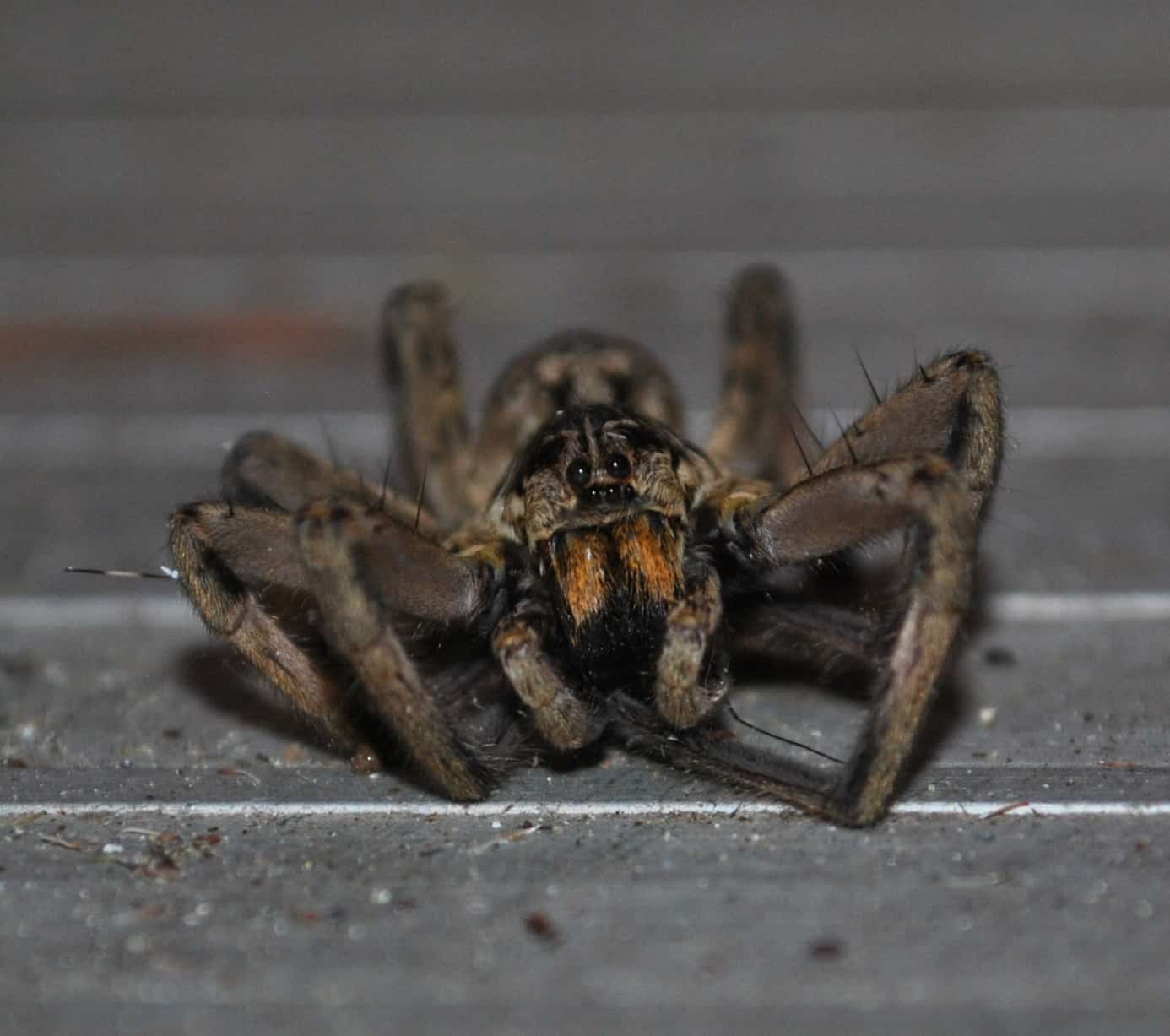
The
wolf spider
‘s venom may not be poisonous but they can still cause uncomfortable systems.
©Aaron Carlson / CC BY-SA 2.0, Flickr – License
Nevada is home to many crawly creatures and the wolf spider is just one of the many spiders whose bite can cause painful symptoms. This spider is one of the most common species in the world and grows to be fairly large, ranging from one-quarter of an inch to two inches long. Unlike other species, this arachnid doesn’t spin webs to catch prey but rather uses its speed to chase them down. They can be found in a variety of locations, from garages, shed and basements to inside logs and under leaves. While their venom is toxic to humans, they do have a rather painful bite, due to their size, and should experience slight pain, swelling, and itching at the site that lasts a few days. However, some people may be allergic to spider bites and can have more severe reactions and should seek medical attention.
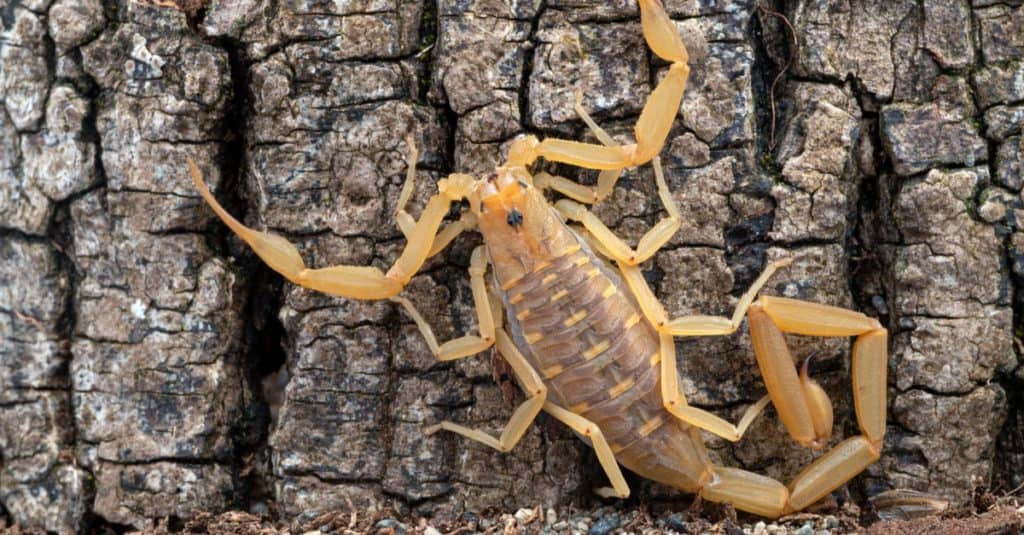
Arizona bark
scorpion
s are fond of climbing trees.
©Ernie Cooper/Shutterstock.com
The most venomous of all scorpions is the Arizona bark scorpion and although it is not native to Nevada, it can now be found in the southern part of the state. These arachnids are small, only reaching lengths of around 2.5 inches, but they pack a mighty punch. Their highly toxic venom can cause severe pain that typically lasts between 24 to 72 hours. Systems can include numbness, tingling, convulsions, and nausea. These scorpions are typically non-aggressive and will only attack when they are protecting themselves as they use their sting as a means of defense.
The photo featured at the top of this post is © Matt Jeppson/Shutterstock.com
Discover the "Monster" Snake 5X Bigger than an Anaconda
Every day A-Z Animals sends out some of the most incredible facts in the world from our free newsletter. Want to discover the 10 most beautiful snakes in the world, a "snake island" where you're never more than 3 feet from danger, or a "monster" snake 5X larger than an anaconda? Then sign up right now and you'll start receiving our daily newsletter absolutely free.
Sources
- Wiley Online Library, Available here: https://onlinelibrary.wiley.com/doi/abs/10.1111/mec.16538
- Desert Museum, Available here: https://www.desertmuseum.org/books/nhsd_shovelnose_snake.php
- Nevada Department Of Wildlife, Available here: https://www.ndow.org/species-information/
- California Herps, Available here: https://californiaherps.com/info/findsnakes.html
- College Of Agriculture, Biotechnology, and Natural Resources, Available here: https://extension.unr.edu/publication.aspx?PubID=3763
Thank you for reading! Have some feedback for us? Contact the AZ Animals editorial team.






